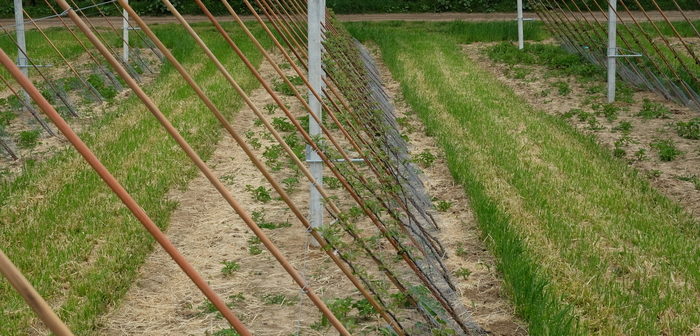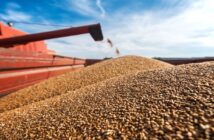Hutchinsons Enhanced Light Interception Orchard System (HELIOS) is a ground breaking 10 year project that that consists of two trial orchards that were planted this spring, one on East Kent, and the other in Herefordshire. The project sets out to explore the question of how orchard design can be improved to capture more sunlight, and thereby increase yield, but balanced against establishment costs, and also mindful of likely future developments in mechanisation such as robotic picking and mechanical pruning. The project leads on from work done in New Zealand by Stuart Tustin, who is based at ‘Plant and Food Research’ in Hawkes Bay. Stuart proposes that yield potential is ultimately a function of light utilisation, and that current orchard systems will always fall short of their theoretical maximum yields as they significantly fail to intercept a proportion of the available sunlight. HELIOS seeks to evaluate his theoretical work in practice, and under UK conditions.
To put this in context, it is clear that orchard design and tree configuration have evolved over time. When Hutchinsons opened their doors to supply the fruit growers of Wisbech 80 years ago, typical commercial orchards would be planted with ‘half standard’ trees at 30ft by 30ft, (48 trees per acre), probably inter-planted with soft fruit in their early years. Progressive growers would have been planting open centre bush trees at 15ft by 15ft (193 trees/acre). By the 1970s intensities increased, and Cox on MM 106 planted at 7ft by 12ft (518 trees/acre) was commonplace. By the 1980s, 3 and 4 row beds of spindle trees on M9 were planted. Some still exist, but challenges with weed control and fruit colour have led to the almost universal adoption of ‘single row post and wire’ orchards, 3.5m between the rows and 1 to 1.25m between the trees. Cordon and espalier tree types have been understood and grown in gardens for vary many years, and perhaps provide a clue of the way forward. A simple planar canopy with little depth can be manipulated to intercept more light and promises to be amenable to increased mechanisation.
The trial orchards also incorporate evaluation of novel tree configurations on M116 rootstock from F.P. Matthews. M116 is of particular interest because of its drought, phytophthora and woolly aphid resistance. M116 should also have a positive influence on reducing canker (due to improved root health) and fruit quality and size for all Gala and Braeburn clones. It is more vigorous than M9, so is being evaluated planted as both ‘laydown’ trees resembling a single guyot grapevine, as well as intensively planted spindle trees but without the support or expense of a wirework trellis. Finally, the sites also host the first UK plantings of a number of varieties from the Netherlands nursery company Carolus.
Growers will have opportunities to view the trial sites and learn about the development of each of the systems in the years to come; watch out for your invitation, or speak to your Hutchinsons agronomist about arranging a visit to HELIOS (in Greek mythology, the god of the sun).




